My friend has started chemotherapy treatments and will soon lose her hair. I wanted to help more than just visiting a couple times (we live 458 miles apart) so I asked if I could make her some head scarves or hats. The answer was yes but the style was completely up to me to choose.
My friend is not a dramatic person, hers is a more casual style. The many turban patterns I found would be out of her comfort zone. I found a super cute cloche pattern but it’s beyond my crochet skill level (which is absolute beginner). I settled on a McCall’s pattern #4116 and chose what I thought from the little picture was a simple scarf. It’s actually a lot more clever than that. It’s shaped by three bands and a separate top. It fits nicely around the head thanks to a little elastic at the nape. The elastic will keep the covering on even if it became untied but it did not feel too snug (I tried it on).
The recommended fabrics were charmeuse, handkerchief linen, and silk noir. I used a cotton gauze. I couldn’t find much else I could use at my local chain fabric store. I avoided polyester because I wanted the fabric to breath. It is on your head after all. The pattern also recommended only 3/8 of a yard for 60″ fabric. I bought 1/2 a yard and so glad I did. When the store clerk was adjusting, over and over, my chosen fabric on the cutting table to line up exactly on the 3/8 line, I remembered what a stingy cut chain stores give you so I asked for a half yard. And then it shrunk, of course, when I washed the fabric. Half a yard turn out perfect.
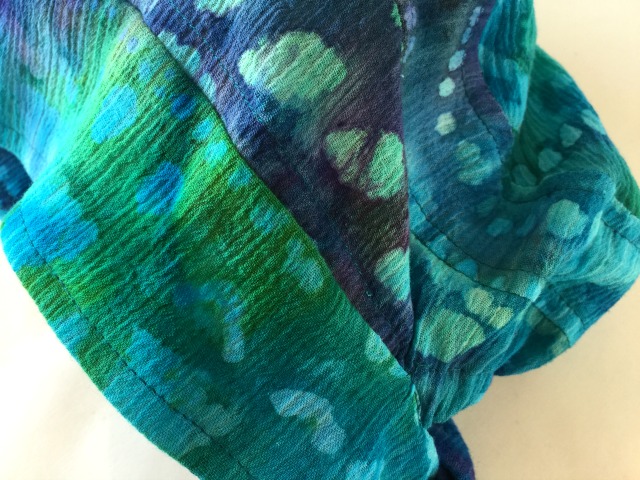
Sewing up the head scarf went fairly fast. It would have been faster without the top stitching but that detail added a really nice touch. There were a few steps in the instructions that were not as clear as they could be but not so bad that I couldn’t figure something out on my own (I’m not sure I did it the way McCall’s intended but then again, they didn’t explain what exactly they intended. Below are two steps and my clarifications).
I did skip top stitching in the back over the elastic casing which already shows stitching on the outside from when I sewed the casing down. With all the gathering the elastic makes and the ties tying over that area I didn’t think the extra stitching was needed. But wait, now I wonder if it’s stitched twice for reinforcement. If that’s the case I will stitch it twice when making the casing as opposed to sewing it again after the elastic is inserted and the fabric gathered.
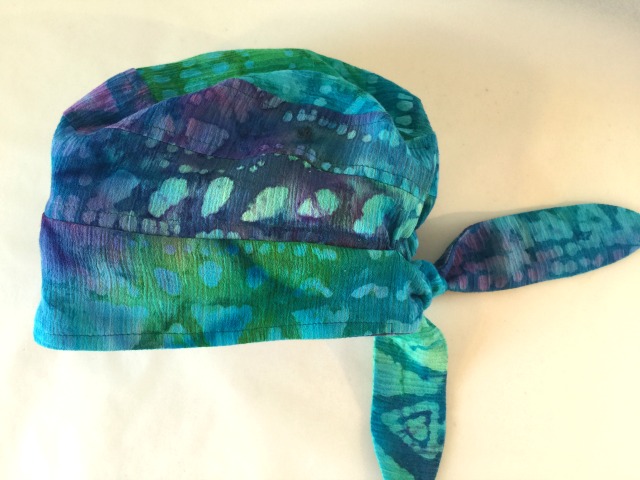
I do recommend using McCall’s 4116 pattern for this view at least. If my friend likes it I will certainly make her another maybe in a subtler print or even solid (She would probably prefer that).
I don’t know what it feels like to not have hair. Undergoing cancer treatment can’t be the first thing anyone wants share with the world. They just want to buy their groceries and go home like all of us. If you know anyone undergoing chemo treatment and losing their hair, consider offering to sew (or knit or crochet) a head covering for them. Surely it would be appreciated and being hand made by you makes it a little extra special.
Here are two, of what I considered vague, steps and my explanation:
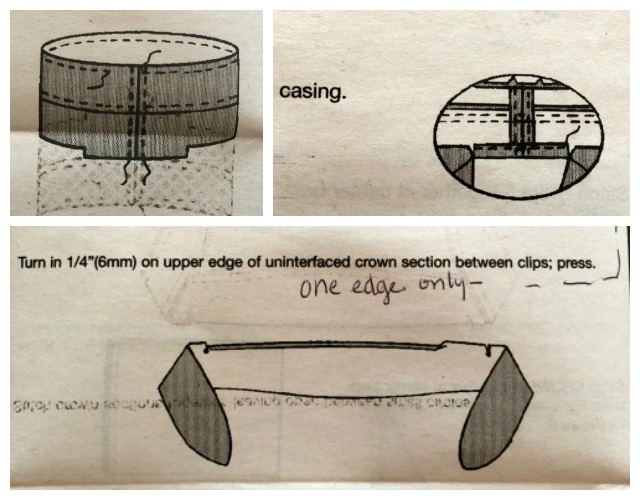
Making the casing for the elastic: The middle band extends 1/4″ beyond the pattern in what turns out to be the back of the hat. This extension is not the casing but the part that folds under and into the casing to give the long end of the casing a clean finish.
This extension is folded up toward the wrong side and pressed making the edge of that band now appear even. The bottom band which is two layers thick (in order to finish the ties and the edge of the hat neatly) sandwiches all of the middle band except this extension; it is left free to form the casing. By folding up a second time the free section of the middle band 5/8″ and stitching it down you make the casing.
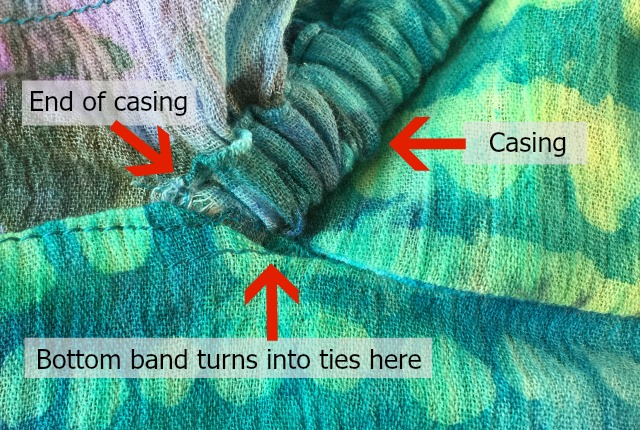
How to cover the raw edge ends of the casing: This is never addressed in the instructions provided. Where the bottom band is no longer attached to the hat but becomes ties there is a clip into the seam allowance of the band. The raw edge of this clipped area overlaps or lines up with (not clear to me) the raw short ends of the casing. I simply folded the clip edge in at an angle. My stitch line then gently ascends from below the seam (where the middle band and bottom band are sewn together) to above the seam which is where McCall’s wants it. Seriously though, next time, I’m folding the entire seam allowance down into itself and stitching the band down in the ditch or below the seam.


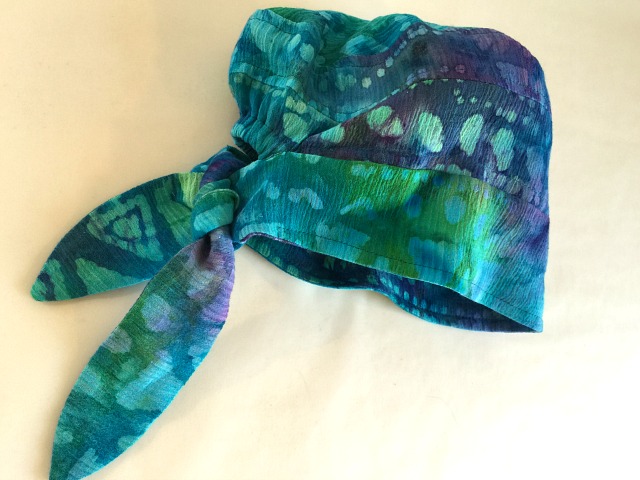
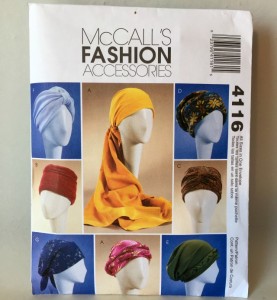
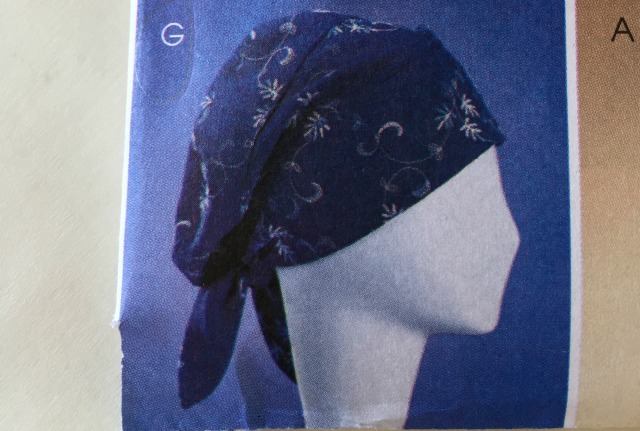
I’m wondering if you used the fleece interfacing that is optional. Thanks so much for such a nice review!
I didn’t use fleece because it was warm weather time. The fleece could be used as interfacing, or as a lining. Flannel can also be used for interfacing adding some warmth for those in-between days when fleece might be too warm.
I’m glad you liked the review, The pattern really sewed up nicely.
Hey! Thank you for your review! I just bought the patterns. I’m doing chemotherapy myself and am about to sew some of the head scarves.
I was just wondering how you measured the sizes? Is it the circumference of your forehead? Or circumference right above the ear? I’m really confused. I’m tossing up between sewing a small or medium.
Thanks for the help!
-Stephanie
So I hunted around a bit for the answer and you measure where you want the hat to sit. It’s kinda’ over the ears and across your forehead (viewing from the side it’s at an angle). And if you’re in between sizes go with the larger size. If you make the version with the ties you could make the medium and tie it closer if it’s a bit large.
The best way to measure is to wrap a piece of string or ribbon around your head. Hold on to the ribbon where the end started to overlap it. Then lay the ribbon flat and measure the length from the end to where it started to overlap. Of course, if you sew you have a tape measure and I don’t see why that wouldn’t work.
When my neighbor underwent chemo treatments, she splurged and bought some gorgeous Liberty of London for her headscarves. She said she needed something beautiful in her life at that moment.
I hope your chemo treatments aren’t too rough and that you’re back to healthy soon. Thanks for reading the blog.